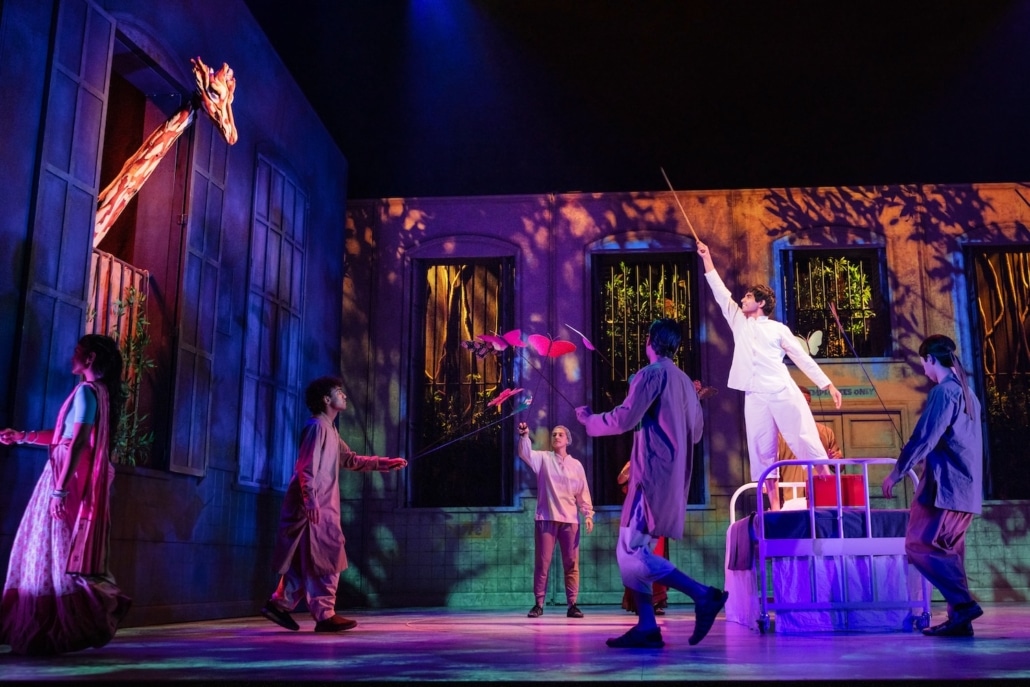DCPA NEWS CENTER
Enjoy the best stories and perspectives from the theatre world today.
Enjoy the best stories and perspectives from the theatre world today.
Click here to see more Life of Pi interviews

Taha Mandviwala as ‘Pi’ and the cast of the National Tour of LIFE OF PI. Photo by Evan Zimmerman for MurphyMade, 2024
Provided by Life of Pi, Education & Resources Packet Team. By Susie Ferguson for Mousetrap Theatre Projects, 2022
Can you start by telling us about the novel?

Yann Martel
Life of Pi is a literary novel which means that it follows fewer rules than genre-based fiction. With romances, murder mysteries, thrillers, etc., there are rules and conventions. However, with literary fiction the lack of rules means that it’s more personal, but it can make the work harder to read. Literary novels plumb the depths of life. I’d say that Life of Pi has elements of adventure and is also highly philosophical. It has religious elements, and it’s set in an exotic settings. The novel is an exploration of particular questions, and each of my novels has explored one particular question I was interested in. Here it’s religious faith.
What was the writing process for Life of Pi?
In my 30s I travelled through India, and for the first time was puzzled by religion: in an age of science and technology and the triumph of these, I was intrigued that something as obscure as religion would endure. I realized that art and religion operate in similar ways. Stories are important in both literature and religious belief.
The novel took 4 ½ years to write in total and the first 2½ were taken up with research. That ranged from looking at animal behavior, biology, reading castaway stories, and finding information about survival at sea. I explored a whole range of subjects. I wrote copious notes, jotted down quotations, and also travelled extensively in India. I did on the ground research, studying Indian English and really getting India under my skin. I also spent a lot of time in the library at McGill University whilst I was living in Montreal doing more theoretical research.
There are three broad strands of research – zoology, religion and survival at sea – and I realized it was way too much to fit all of it into the novel. In the actual chapters, I would only use a fraction of that research but I gained a huge amount of knowledge and could definitely impersonate a zookeeper in my mind!
The process generated about 700 pages of notes on a Word document, which also consisted of ideas for scenes, dialogue, observations and ideas. Once I had all of that information, printed on paper, I then used scissors to cut up all the research and put it in different envelopes, depending on where they belong in the novel. The first envelope was called ‘Author’s Note’, the second envelope was the first chapter when Pi is in Canada. What was in the envelopes was the backbone of each chapter and then I’d flesh out that chapter.
The novel has a feel of gritty realism, so I needed a really thorough knowledge of the topics.
You have to do your research. Then you reach a point where you can close your eyes and imagine yourself in the skin of the character.
What are the themes of the novel?
Life of Pi explores the idea that life is an interpretation. It’s not just about facts, but how you interpret those facts. You can have one set of facts that can generate two entirely different stories.
This is key in Life of Pi. At the heart of Life of Pi is this notion that a ship sinks and after 227days a boy arrives on the coast of Mexico in a life boat. These facts are incontrovertible, but what happens in between is not. One is a story with animals, one is a story without.
In the theatrical adaptation, both stories are told equally and the audience is free to choose between those two stories. Do you want to live a life that cleaves most to reason and facts, or one that takes greater leaps of the imagination? It’s the latter version where art and religion become important notions.
When I wrote the book, I didn’t concern myself with what the book might mean to people. I had a notion of two stories based on the same set of facts and the same number of characters.
When it was unexpectedly successful, I was often asked about the meaning of Richard Parker. Initially I drew a blank! Then all these perceptive readers were giving me answers which I then started feeding to my next group of readers! Broadly speaking there are two stories told in parallel and the characters are paired off. The zebra is the Taiwanese sailor, the orangutan is paired off with Pi’s mother, the hyena is the French cook, and then the pair we have left is Richard Parker and Pi. They symbolically echo each other. Both share a dogged desire to live, and keep living, and both do what needs doing to achieve that.
What interpretations have people offered about the meaning of the novel?
Some interpretations would say that the tiger is a figment of Pi’s imagination and symbolizes his determination to survive. In this version, he can’t accept what he did – that he killed the cook who killed his mother. He survived, but at what cost? Perhaps it is all a big lie he told himself to make an ugly truth acceptable. Some people say the tiger could be God – at one point Pi says he couldn’t have survived without the tiger; it gave him a reason to live. Many people would say that about the Divine – it’s something that keeps Pi alive. The Old Testament talks of the fear of God, so Pi is both in love with and frightened of Richard Parker. One person even said the relationship between Richard Parker and Pi is a metaphor for marriage! The most obvious interpretation is that it’s a parallel – Richard Parker is a parallel creature to Pi.
The description of Richard Parker is detailed. Was it difficult to write?
I don’t remember it being difficult to write. There were other sections that were much more difficult. Words are not good at descriptions, particularly if things are unfamiliar. My Chinese translator didn’t know what a sea anchor is – I spent a lot of time trying to explain. Most people know tigers, they can visualize one and you just fill in the outline.
What’s interesting about writing is that the things you’d expect to be difficult, aren’t, but the utterly mundane is very difficult. I remember in the Author’s Note at the very end when he thanks various people including the Canada Council for the Arts, and the Japanese Embassy was really hard. I remember really struggling even though it’s completely unimportant whilst the crucial stuff seemed to come quite easily. The tiger description is vaguely theatrical. Tiger stripes are like our fingerprints, they’re totally unique – no two faces are identical, very much like Chinese theatrical make up.
A good example of the difference between writing in a novel and creating that story for the stage is the sinking of the Tsimtsum. To me, that was a way of Pi getting to the lifeboat with the tiger. So I simply wrote, “The ship sank” and described a “monstrous metallic burp” but then it quickly moves on to how that feels for Pi, and his emotional reaction.
For a film maker this moment is a God send! It’s quite a beautiful scene in the film and those three words become an entire scene that’s forcefully told. However Pi’s dialogue to Richard Parker just vanishes. What is strong in one medium is not in another. All the mental rumination about religion is lost in the film and sometimes in the play because of the visual component of both of those two forms. They are inherently visual media.
What are the challenges of adapting a novel for stage or screen?
Writing a book involves writing and rewriting, and then your editor tells you to rewrite even more! Books take a long time to write but they tend to be a successful form of storytelling. The challenge for the adaption of any novel is that you necessarily lose something moving from one to another. Each medium has its own strengths and weaknesses and you write for that specific medium.
Adaptation is difficult. You gain a lot though – the immediacy of the actors, for example. You gain the fact that the audience has already agreed to suspend their disbelief (whereas cinema needs lots of special effects to achieve the same effect). People who’ve read the book will recognize novel in the play or movie. They’ll fill in any holes that might be in the adaptation. Adaptation just tells a story in a different way. Some people are natural readers, who enjoy the quiet of reading, and when you read a book you’re sort of creating a little movie in your mind. That’s very empowering, you are the director, the designer etc. Others prefer visual and aural storytelling, and the play or cinema provides the social experience too. I don’t need to be possessive!
How were you involved in creating the adaptation?
I assisted at one week of workshopping, but I stepped back very quickly because I immediately recognized this was not my language. I can understand the language of prose and novel writing, but the language of theatre is a different instrument.
Adaptation within the rehearsal room is very collaborative, whereas I’m used to writing in the quiet of my mind. What works on the page doesn’t necessarily work on the stage, and vice versa. Therefore you have to let go, and trust the artists who are adapting the story because they know what they’re doing and it’s their artistic risk.
I had a lunchtime conversation with Lolita Chakrabarti (playwright) – we discussed the novel in detail and I told her what the novel is about for me. Of course, everyone has their own interpretation and Lolita has done a great job. She periodically showed me drafts, but I would only guide with small things such as ‘this doesn’t sound like something Pi would say ’but nothing much more than that.
I remember giving the odd little perspective. For example, there were discussions about the other people who would arrive when Pi reaches Mexico. But those people can’t see the tiger– the only person who can witness Richard Parker is Pi.
If someone is adapting one’s work, we must trust the risk taking of the adapters – the more freedom they have, the better the adaptation will be.
Life of Pi is a tricky story to adapt because the mistake most people make is that they have to get to the boy in the lifeboat in the Pacific as quickly as possible. In fact, not much happens once he’s on the boat– it’s a domestic drama and there’s a guy and his big cat, he periodically feeds his big cat, and he loses weight. The real tension comes at the end in the hospital in Mexico when you realize there are two stories being told.
What advice can you give to anyone who’s adapting a novel into a play?
Well, what I’d say is when adapting a novel or a story, you need to look where its heart lies. What is the actual moving force?
That’s the same with any book – you need to ask what it’s really about. Some people get caught up in what’s loudest and flashiest which isn’t necessarily where the story is at. Go deeper and see what’s really driving the story.
